Texas Roadhouse Bundle
Who Really Calls the Shots at Texas Roadhouse?
Ever wondered who steers the ship at one of America's favorite steakhouses? Understanding the Texas Roadhouse SWOT Analysis reveals more than just its strengths and weaknesses; it unveils the core of its operational strategies. Knowing the Texas Roadhouse owner and the Texas Roadhouse ownership structure is key to grasping its future direction and market performance. Delving into the Texas Roadhouse company's ownership provides critical insights for investors and business strategists alike.
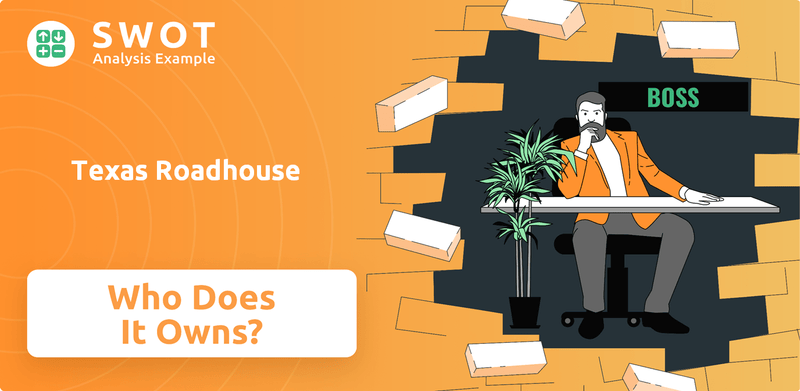
From its humble beginnings in Indiana to its current status as a publicly traded entity, the Texas Roadhouse history is a fascinating study in growth and adaptation. This analysis will explore the evolution of Who owns Texas Roadhouse, examining the major shareholders, the influence of institutional investors, and the role of the board of directors. Furthermore, we'll uncover the financial performance of the Texas Roadhouse company, including its revenue and earnings, providing a comprehensive overview for informed decision-making. Understanding the current Texas Roadhouse CEO and their influence will also be a key focus.
Who Founded Texas Roadhouse?
The story of Texas Roadhouse begins with W. Kent Taylor, who founded the company in 1993. Taylor's vision led to the opening of the first restaurant in Clarksville, Indiana, marking the start of a now-significant player in the casual dining sector. This initial venture was built on Taylor's determination and ability to secure funding, setting the stage for its future growth.
Taylor's journey to establish the company was marked by perseverance. After facing numerous rejections, he eventually secured the necessary capital to launch the first location. This initial funding was crucial, as it allowed Taylor to bring his restaurant concept to life and begin building the brand. The early days were critical for establishing the foundation of what would become a successful chain.
The early ownership structure centered around W. Kent Taylor. He initially held the rights to a royalty distribution from all sales of company and licensed restaurants. This arrangement provided Taylor with a direct stake in the company's success. Through subsequent transactions, his ownership was consolidated, setting the stage for the company's initial public offering (IPO) in 2004.
Initial funding came from three cardiologists in Elizabethtown, Kentucky, who invested $300,000.
The first restaurant opened on February 17, 1993, in Clarksville, Indiana.
W. Kent Taylor was the sole stockholder of WKT Restaurant Corp., receiving royalties.
The IPO in 2004 restructured ownership, consolidating Taylor's holdings.
Taylor received shares of Class A and Class B common stock during the IPO.
Taylor contributed his franchise interests for additional shares.
The Texas Roadhouse ownership
structure evolved from W. Kent Taylor's initial sole proprietorship to a more complex arrangement. The early funding from investors and Taylor's restructuring efforts were pivotal in the company's growth. Today, understanding who owns Texas Roadhouse
involves examining its publicly traded status and the roles of major shareholders. The company's history reflects a journey from its founding to its current position in the market. Here are some key facts about the company:
- W. Kent Taylor founded the company in 1993.
- Initial funding came from investors, with Taylor later consolidating ownership.
- The company went public in 2004, changing the ownership structure.
- The current
Texas Roadhouse CEO
is Jerry Morgan, as of 2024. - As of 2024, there are over 680 locations.
Texas Roadhouse SWOT Analysis
- Complete SWOT Breakdown
- Fully Customizable
- Editable in Excel & Word
- Professional Formatting
- Investor-Ready Format
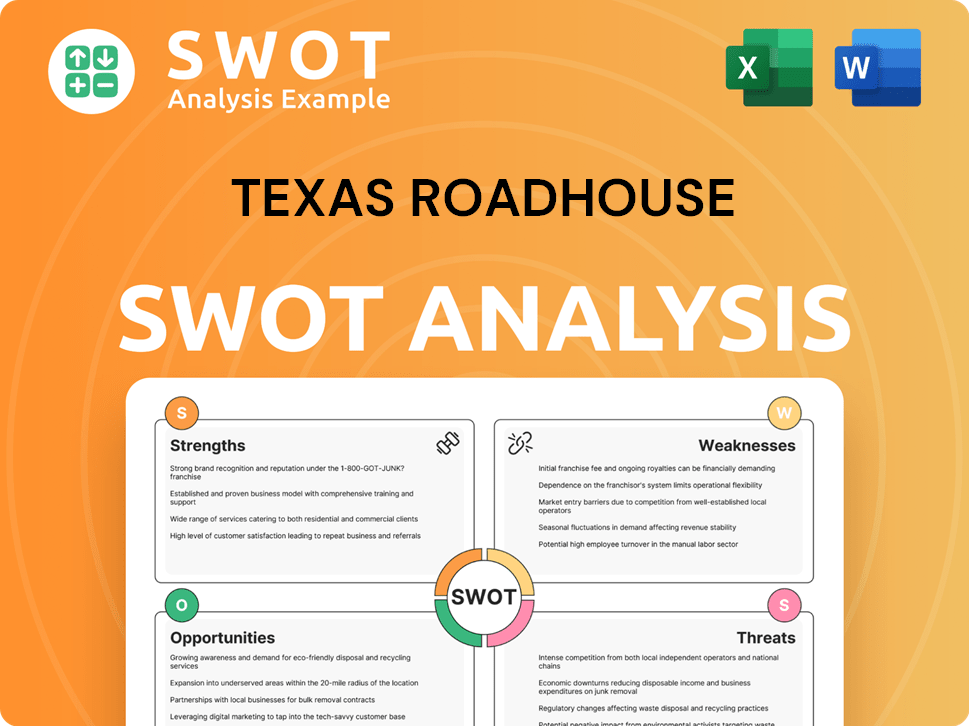
How Has Texas Roadhouse’s Ownership Changed Over Time?
The evolution of Texas Roadhouse's ownership has been marked by significant milestones since its inception. The company went public on October 5, 2004, through an initial public offering (IPO). At the IPO, shares were sold at $17.50 each, raising $159.3 million. Founder W. Kent Taylor retained substantial control after the IPO, holding approximately 61.6% of the company's stock. The company's stock trades on the Nasdaq National Market under the symbol 'TXRH'.
The ownership structure has evolved over time, with a shift towards institutional investors. As of December 31, 2024, institutional investors held a significant portion of the company's shares, about 93.10%. This demonstrates the confidence of major financial institutions in the company's performance and future. The shift towards institutional ownership has been a key trend, reflecting the company's growth and stability in the market. To understand the company's customer base, check out the Target Market of Texas Roadhouse.
| Stakeholder | Shares Held (as of March 31, 2025) | Percentage of Ownership |
|---|---|---|
| Vanguard Group Inc. | 4,978,188 | 9.52% |
| BlackRock Fund Advisors | 3,978,749 | 7.61% |
| State Street Global Advisors, Inc. | 2,187,541 | 4.18% |
As of December 31, 2024, insider ownership, which includes executives and directors, was at 0.54%. Key institutional holders like Vanguard Group Inc. and BlackRock Fund Advisors play a crucial role in the company's market dynamics. These institutional holdings highlight their influence on the company's performance.
The ownership of Texas Roadhouse has evolved significantly since its IPO in 2004. Institutional investors now hold the majority of shares, reflecting confidence in the company's growth.
- The IPO in 2004 marked a significant change, making the company publicly traded.
- Founder W. Kent Taylor initially held a substantial portion of the stock.
- Institutional investors, like Vanguard and BlackRock, are now major stakeholders.
- Insider ownership remains a smaller percentage compared to institutional holdings.
Texas Roadhouse PESTLE Analysis
- Covers All 6 PESTLE Categories
- No Research Needed – Save Hours of Work
- Built by Experts, Trusted by Consultants
- Instant Download, Ready to Use
- 100% Editable, Fully Customizable
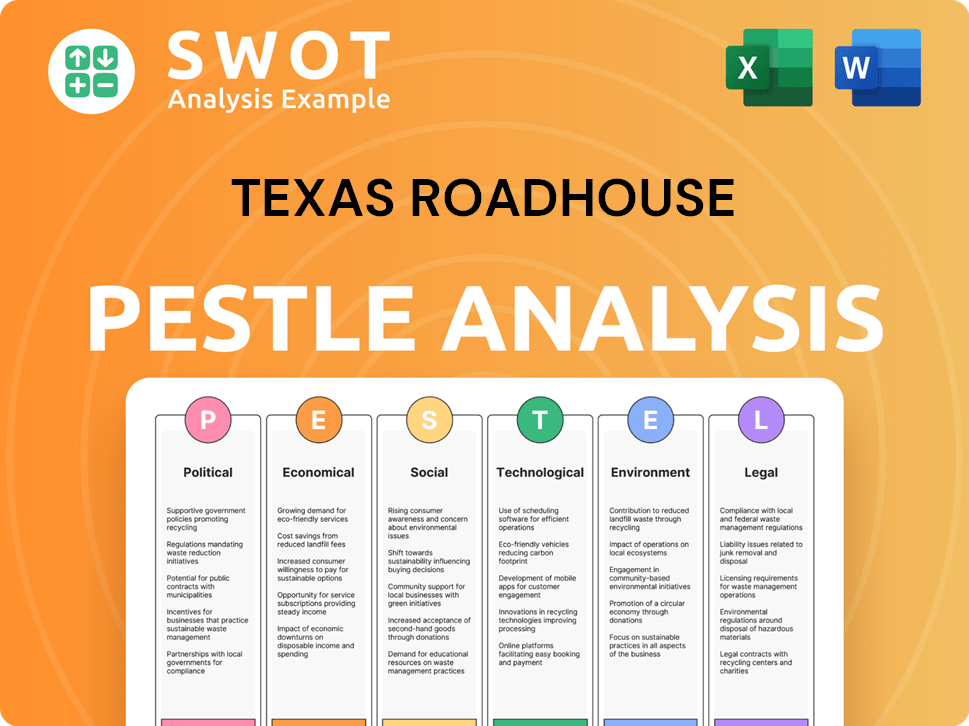
Who Sits on Texas Roadhouse’s Board?
As of March 1, 2024, the Board of Directors of Texas Roadhouse, Inc. comprised nine members, playing a vital role in the company's governance. The board includes key figures such as Gregory N. Moore, serving as Chairman, and Gerald L. Morgan, the Chief Executive Officer. Jane Grote Abell joined the board on March 1, 2024, bringing extensive experience from the restaurant industry. Additional directors include Donna E. Epps, Curtis Warfield, and James R. Zarley. The average tenure for board members is approximately 8.2 years.
The board's composition ensures strategic oversight and direction for the company. The board's structure and the diverse backgrounds of its members support informed decision-making and effective governance. The board's role is critical in guiding the company's long-term strategy and ensuring accountability to shareholders. Understanding the board's composition provides insight into the leadership and direction of the company.
| Director | Title | Since |
|---|---|---|
| Gregory N. Moore | Chairman of the Board | 2004 |
| Gerald L. Morgan | Chief Executive Officer | 2024 |
| Jane Grote Abell | Director | 2024 |
| Donna E. Epps | Director | 2019 |
| Curtis Warfield | Director | 2019 |
| James R. Zarley | Director | 2014 |
Regarding voting rights, each share of common stock grants one vote on shareholder matters. There is no cumulative voting for board of director elections. Historically, the company had Class A and Class B common stock. Initially, Class B stock, held by W. Kent Taylor, had ten votes per share, while Class A stock had one vote per share. Upon the initial public offering, W. Kent Taylor held 2,632,688 shares of Class B common stock and 8,689,310 shares of Class A common stock, representing approximately 61.6% of the voting power. As of December 31, 2024, the company has one class of securities registered under Section 12 of the Securities Exchange Act of 1934: Common Stock of $0.001 par value. Special shareholder meetings can be called by the board, the chairman, the CEO, the president, or the secretary upon a written request from shareholders holding at least 25% of the voting power. For more context on the competitive environment, you can explore the Competitors Landscape of Texas Roadhouse.
The board of directors oversees the company's strategic direction.
- The board consists of nine members as of March 1, 2024.
- Each share of common stock has one vote.
- Special meetings can be called by shareholders owning at least 25% of the voting power.
- The current CEO is Gerald L. Morgan.
Texas Roadhouse Business Model Canvas
- Complete 9-Block Business Model Canvas
- Effortlessly Communicate Your Business Strategy
- Investor-Ready BMC Format
- 100% Editable and Customizable
- Clear and Structured Layout
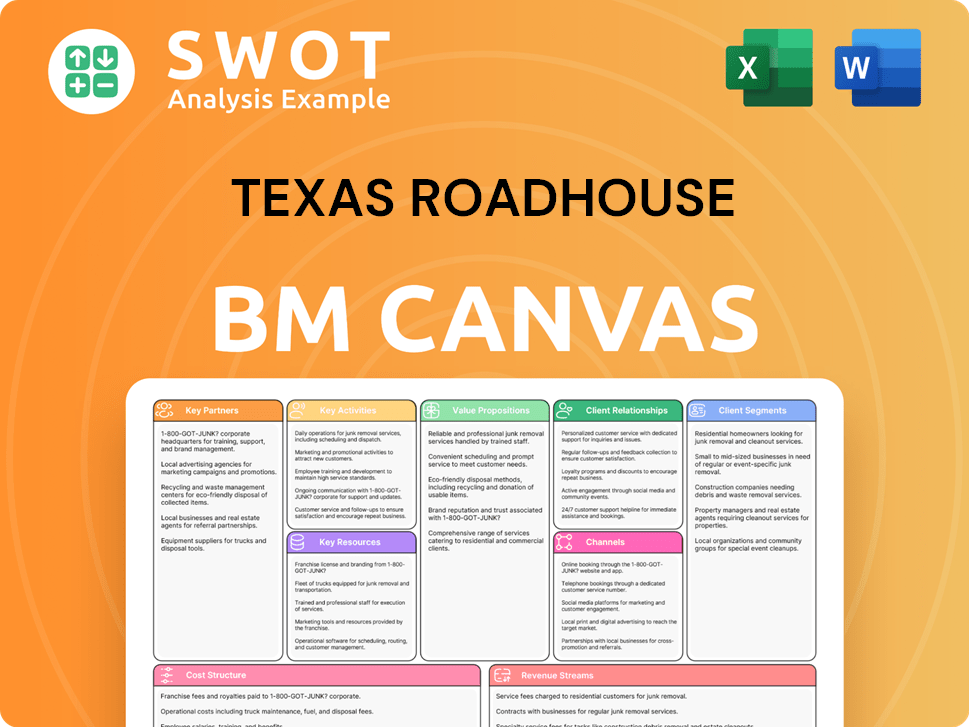
What Recent Changes Have Shaped Texas Roadhouse’s Ownership Landscape?
Recent developments show a robust financial performance for the company. For the fiscal year ending December 31, 2024, total revenue reached $5.37 billion, a 16.01% increase from the previous year. The Board of Directors approved an 11% increase in the quarterly cash dividend to $0.68 per share on February 19, 2025, and authorized a stock repurchase program of up to $500 million. As of April 1, 2025, the company had $479.8 million remaining under this program, with $50.15 million in shares repurchased in the quarter ending March 31, 2025, and $35.10 million in the quarter ending December 31, 2024. The annual share buybacks for 2024 were $80.003 million.
The company's expansion strategy includes opening 30 new locations in 2025 across its various brands. On the first day of the 2025 fiscal year, the company acquired 13 domestic franchise restaurants for approximately $78 million. This expansion involves international growth into Mexico and the Middle East, along with domestic Jaggers franchise partners targeting three new locations. As of April 1, 2025, the company owned and operated 688 restaurants and franchised an additional 104 restaurants across 49 states, one U.S. territory, and ten foreign countries. The company's 800th restaurant is under construction and is expected to open later in 2025.
| Metric | Value | Date |
|---|---|---|
| Total Revenue | $5.37 billion | Fiscal Year Ended December 31, 2024 |
| Dividend Increase | 11% | February 19, 2025 |
| Stock Repurchase Program | Up to $500 million | February 19, 2025 |
| Shares Repurchased (Q1 2025) | $50.15 million | March 31, 2025 |
| Shares Repurchased (Q4 2024) | $35.10 million | December 31, 2024 |
| Annual Share Buybacks (2024) | $80.003 million | 2024 |
| Acquisition of Franchise Restaurants | 13 | Fiscal Year 2025 |
| Restaurants Owned and Operated | 688 | April 1, 2025 |
| Franchised Restaurants | 104 | April 1, 2025 |
Institutional ownership continues to be a significant aspect of the company's ownership structure. As of May 2025, approximately 93.71% of the company's stock is held by institutional shareholders. Vanguard Group Inc. and BlackRock, Inc. are among the largest institutional holders. BlackRock, Inc. disclosed ownership of 6,202,347 shares, representing 9.3% of the company, as of April 17, 2025. For more insights into the company's strategic growth, you can read about the Growth Strategy of Texas Roadhouse.
Institutional investors hold a significant portion of the company's stock. Vanguard and BlackRock are major shareholders.
The ownership is primarily institutional, with approximately 93.71% of shares held by institutional investors as of May 2025.
Yes, Texas Roadhouse is a publicly traded company, and its stock is available for investment.
The current CEO of Texas Roadhouse is not mentioned in the provided text.
Texas Roadhouse Porter's Five Forces Analysis
- Covers All 5 Competitive Forces in Detail
- Structured for Consultants, Students, and Founders
- 100% Editable in Microsoft Word & Excel
- Instant Digital Download – Use Immediately
- Compatible with Mac & PC – Fully Unlocked
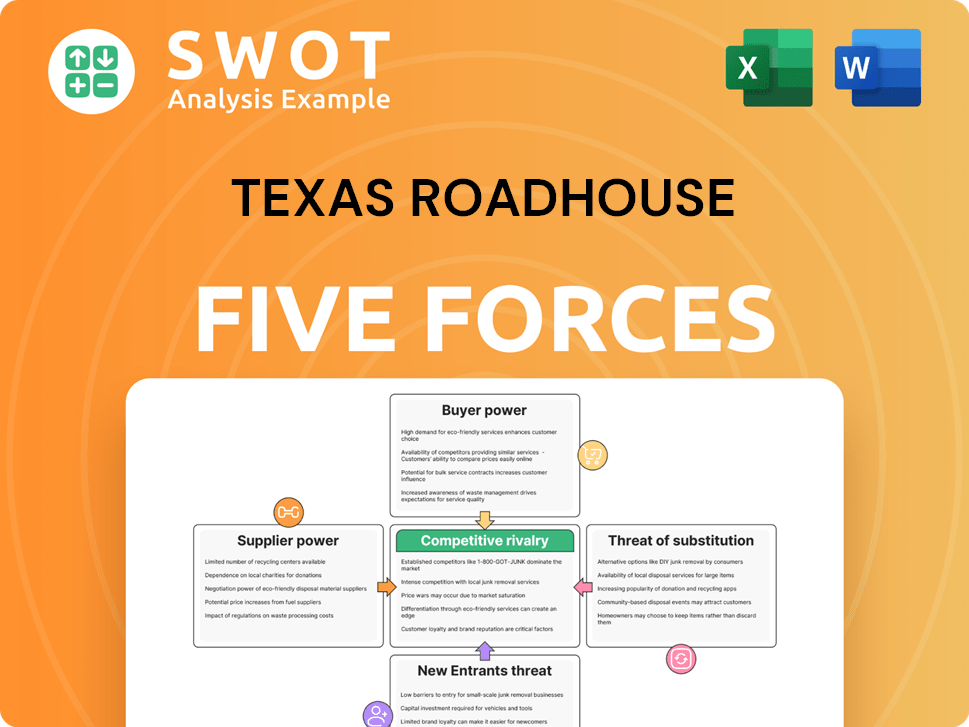
Related Blogs
- What are Mission Vision & Core Values of Texas Roadhouse Company?
- What is Competitive Landscape of Texas Roadhouse Company?
- What is Growth Strategy and Future Prospects of Texas Roadhouse Company?
- How Does Texas Roadhouse Company Work?
- What is Sales and Marketing Strategy of Texas Roadhouse Company?
- What is Brief History of Texas Roadhouse Company?
- What is Customer Demographics and Target Market of Texas Roadhouse Company?
Disclaimer
All information, articles, and product details provided on this website are for general informational and educational purposes only. We do not claim any ownership over, nor do we intend to infringe upon, any trademarks, copyrights, logos, brand names, or other intellectual property mentioned or depicted on this site. Such intellectual property remains the property of its respective owners, and any references here are made solely for identification or informational purposes, without implying any affiliation, endorsement, or partnership.
We make no representations or warranties, express or implied, regarding the accuracy, completeness, or suitability of any content or products presented. Nothing on this website should be construed as legal, tax, investment, financial, medical, or other professional advice. In addition, no part of this site—including articles or product references—constitutes a solicitation, recommendation, endorsement, advertisement, or offer to buy or sell any securities, franchises, or other financial instruments, particularly in jurisdictions where such activity would be unlawful.
All content is of a general nature and may not address the specific circumstances of any individual or entity. It is not a substitute for professional advice or services. Any actions you take based on the information provided here are strictly at your own risk. You accept full responsibility for any decisions or outcomes arising from your use of this website and agree to release us from any liability in connection with your use of, or reliance upon, the content or products found herein.